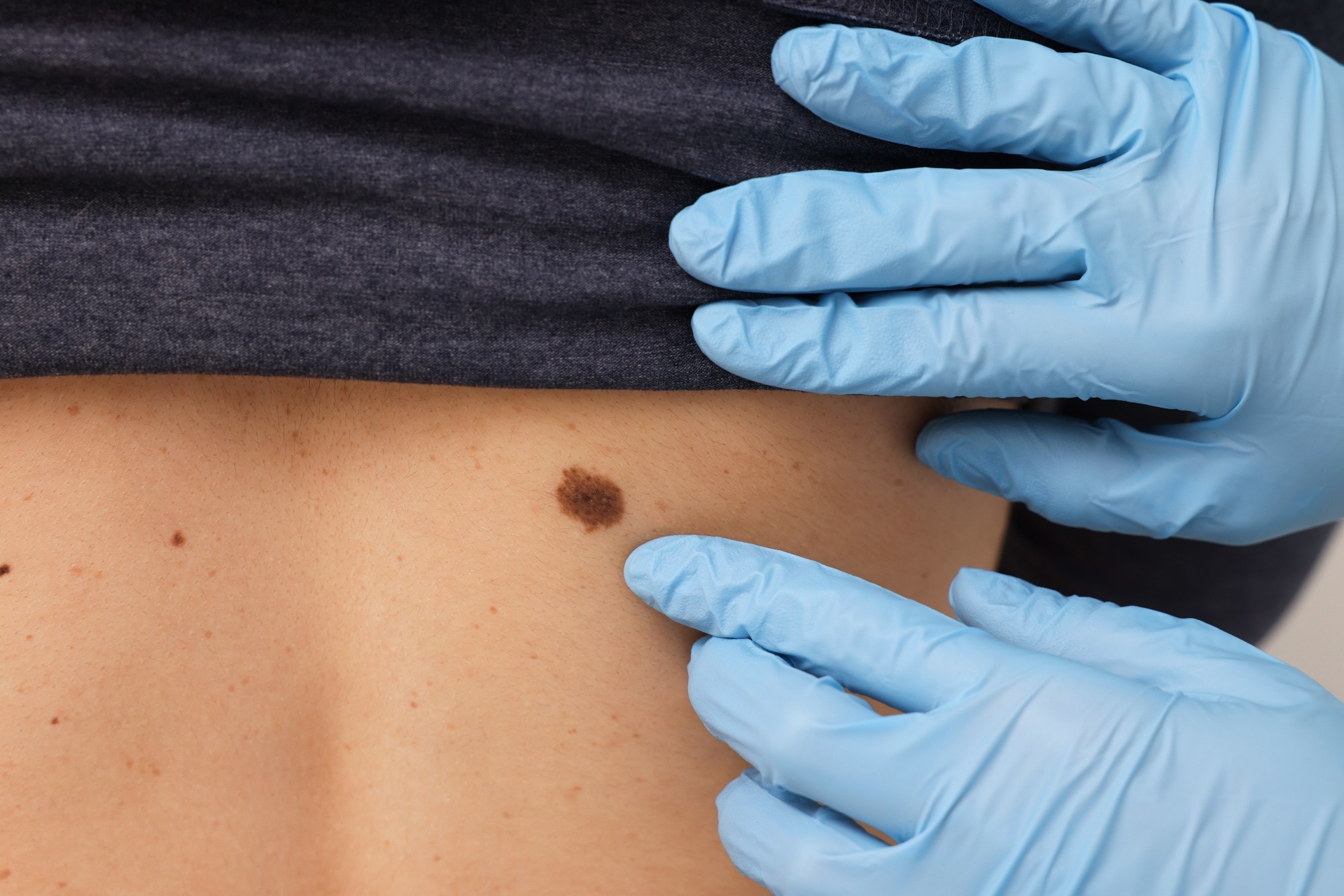A recent study published in Small addresses the persistent difficulty of treating refractory melanoma, an aggressive form of skin cancer that often does not respond to existing therapies.
Although diagnostic tools and immunotherapies have improved in recent years, a substantial number of patients remain unresponsive to current treatment options, highlighting the need for alternative therapeutic approaches.

Image Credit: New Africa/Shutterstock.com
The researchers in this study explore a strategy that combines intracellular stress targeting with immune modulation.
Specifically, they investigate the co-administration of two hydrophobic drugs: copper diethyldithiocarbamate (CuET), which inhibits the p97-UFD1-NPL4 protein complex to induce endoplasmic reticulum (ER) stress and promote cytotoxicity; and 6-bromo-indirubin-3′-oxime (BIO), a GSK3 inhibitor that can influence inflammatory pathways and tumor cell growth.
Background
Melanoma becomes particularly difficult to treat once it develops resistance to standard therapies. Tumor cells can avoid immune detection and resist cell death mechanisms, reducing the effectiveness of many treatments. This study focuses on targeting both cellular stress pathways and immune checkpoints as a dual approach.
CuET disrupts protein degradation by inhibiting the p97-UFD1-NPL4 complex, leading to ER stress and apoptosis, especially in cancer cells already under stress. BIO, as a GSK3 inhibitor, affects β-catenin signaling and the production of inflammatory cytokines, which can help reshape the tumor microenvironment to enhance immune recognition.
Because both CuET and BIO are hydrophobic, systemic delivery is a challenge. To address this, the researchers developed liposome-polymer nanoparticles (LPNs) capable of encapsulating the drugs, improving their solubility, delivery precision, and release control.
The Current Study
The research included both in vitro and in vivo experiments to evaluate the drug delivery system. The team first established the optimal molar ratio of CuET to BIO using several melanoma cell lines, including B16F10 and YUMM1.7, along with their variants.
The drugs were co-loaded into LPNs made from phospholipids and stabilized with poly(vinylpyrrolidone), which improved their compatibility in aqueous environments. Particle size, surface charge, encapsulation efficiency, and stability were analyzed using dynamic light scattering and electron microscopy.
Cellular uptake and cytotoxicity were assessed using viability assays (including the sulforhodamine B method) in both two-dimensional cell cultures and three-dimensional tumor spheroids. Additional analyses (such as immunofluorescence, Western blotting, and flow cytometry) were used to track changes in β-catenin levels, immune marker expression, and T cell activation.
In vivo, the LPNs were tested in mouse models of melanoma, again using the B16F10 and YUMM1.7 cell lines, which exhibit features of therapy-resistant disease. Tumor growth, metastasis, and treatment-related toxicity were monitored through imaging, histological evaluation, and blood analysis.
Results and Discussion
The co-loaded nanoparticles demonstrated consistent particle size (100–150 nm), high encapsulation efficiency, and stability under physiological conditions. In vitro, the combination therapy showed a greater reduction in melanoma cell viability than either drug alone, indicating a synergistic cytotoxic effect.
One notable finding was BIO’s ability to counteract the accumulation of β-catenin induced by CuET. This suggests that the drug pair can modulate intracellular signaling in a way that may limit tumor proliferation and reduce metastatic potential. The combination also increased markers of ER stress and apoptosis, supporting the idea that the two drugs operate through complementary mechanisms.
Beyond direct effects on tumor cells, the study also examined the immune-related impact of the treatment. The combination therapy led to reduced expression of PD-L1 on tumor cells, potentially improving immune cell recognition. Flow cytometry revealed increased levels of immune activation markers such as CD69, along with changes in PD-1 expression on T cells. CuET alone increased PD-1 levels, a response that was moderated by the addition of BIO.
CuET was also found to suppress IL-2 secretion from activated T cells, directly influencing immune cell function. These results suggest that the therapy engages both tumor-intrinsic and immune-modulatory pathways, contributing to a more comprehensive anti-tumor response.
In vivo, treatment with the liposome-polymer nanoparticles led to a significant decrease in tumor size—about 47 % in B16F10 models and over 75 % in YUMM1.7 models. Importantly, this effect was achieved without significant toxicity. Mice maintained stable body weight, and blood and histological analyses showed no signs of liver or kidney damage.
Overall, the findings support the use of this nanocarrier system for delivering hydrophobic drug combinations, offering effective tumor suppression with a favorable safety profile.
Conclusion
This study presents a liposome-polymer nanoparticle system designed to deliver CuET and BIO in combination as a potential treatment for resistant melanoma. The formulation demonstrated stability, effective tumor suppression in vitro and in vivo, and a favorable safety profile.
By targeting ER stress, β-catenin signaling, and immune checkpoint pathways, the approach offers a multi-faceted therapeutic option for melanoma that has not responded to existing treatments.
Further research may explore the use of similar delivery systems for other drug combinations, particularly in cancers where treatment resistance remains a significant challenge.
Journal Reference
Paun R. A., et al. (2025). Liposome-Polymer Nanoparticles Loaded with Copper Diethyldithiocarbamate and 6-Bromo-Indirubin-3′-Oxime Enable the Treatment of Refractive Melanoma. Small, DOI: 10.1002/smll.202409012, https://onlinelibrary.wiley.com/doi/10.1002/smll.202409012
News
Lower doses of immunotherapy for skin cancer give better results, study suggests
According to a new study, lower doses of approved immunotherapy for malignant melanoma can give better results against tumors, while reducing side effects. This is reported by researchers at Karolinska Institutet in the Journal of the National [...]
Researchers highlight five pathways through which microplastics can harm the brain
Microplastics could be fueling neurodegenerative diseases like Alzheimer's and Parkinson's, with a new study highlighting five ways microplastics can trigger inflammation and damage in the brain. More than 57 million people live with dementia, [...]
Tiny Metal Nanodots Obliterate Cancer Cells While Largely Sparing Healthy Tissue
Scientists have developed tiny metal-oxide particles that push cancer cells past their stress limits while sparing healthy tissue. An international team led by RMIT University has developed tiny particles called nanodots, crafted from a metallic compound, [...]
Gold Nanoclusters Could Supercharge Quantum Computers
Researchers found that gold “super atoms” can behave like the atoms in top-tier quantum systems—only far easier to scale. These tiny clusters can be customized at the molecular level, offering a powerful, tunable foundation [...]
A single shot of HPV vaccine may be enough to fight cervical cancer, study finds
WASHINGTON -- A single HPV vaccination appears just as effective as two doses at preventing the viral infection that causes cervical cancer, researchers reported Wednesday. HPV, or human papillomavirus, is very common and spread [...]
New technique overcomes technological barrier in 3D brain imaging
Scientists at the Swiss Light Source SLS have succeeded in mapping a piece of brain tissue in 3D at unprecedented resolution using X-rays, non-destructively. The breakthrough overcomes a long-standing technological barrier that had limited [...]
Scientists Uncover Hidden Blood Pattern in Long COVID
Researchers found persistent microclot and NET structures in Long COVID blood that may explain long-lasting symptoms. Researchers examining Long COVID have identified a structural connection between circulating microclots and neutrophil extracellular traps (NETs). The [...]
This Cellular Trick Helps Cancer Spread, but Could Also Stop It
Groups of normal cbiells can sense far into their surroundings, helping explain cancer cell migration. Understanding this ability could lead to new ways to limit tumor spread. The tale of the princess and the [...]
New mRNA therapy targets drug-resistant pneumonia
Bacteria that multiply on surfaces are a major headache in health care when they gain a foothold on, for example, implants or in catheters. Researchers at Chalmers University of Technology in Sweden have found [...]
Current Heart Health Guidelines Are Failing To Catch a Deadly Genetic Killer
New research reveals that standard screening misses most people with a common inherited cholesterol disorder. A Mayo Clinic study reports that current genetic screening guidelines overlook most people who have familial hypercholesterolemia, an inherited disorder that [...]
Scientists Identify the Evolutionary “Purpose” of Consciousness
Summary: Researchers at Ruhr University Bochum explore why consciousness evolved and why different species developed it in distinct ways. By comparing humans with birds, they show that complex awareness may arise through different neural architectures yet [...]
Novel mRNA therapy curbs antibiotic-resistant infections in preclinical lung models
Researchers at the Icahn School of Medicine at Mount Sinai and collaborators have reported early success with a novel mRNA-based therapy designed to combat antibiotic-resistant bacteria. The findings, published in Nature Biotechnology, show that in [...]
New skin-permeable polymer delivers insulin without needles
A breakthrough zwitterionic polymer slips through the skin’s toughest barriers, carrying insulin deep into tissue and normalizing blood sugar, offering patients a painless alternative to daily injections. A recent study published in the journal Nature examines [...]
Multifunctional Nanogels: A Breakthrough in Antibacterial Strategies
Antibiotic resistance is a growing concern - from human health to crop survival. A new study successfully uses nanogels to target and almost entirely inhibit the bacteria P. Aeruginosa. Recently published in Angewandte Chemie, the study [...]
Nanoflowers rejuvenate old and damaged human cells by replacing their mitochondria
Biomedical researchers at Texas A&M University may have discovered a way to stop or even reverse the decline of cellular energy production—a finding that could have revolutionary effects across medicine. Dr. Akhilesh K. Gaharwar [...]
The Stunning New Push to Protect the Invisible 99% of Life
Scientists worldwide have joined forces to build the first-ever roadmap for conserving Earth’s vast invisible majority—microbes. Their new IUCN Specialist Group reframes conservation by elevating microbial life to the same urgency as plants and [...]





















